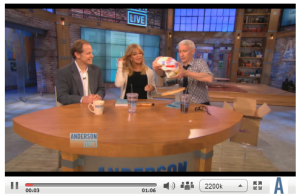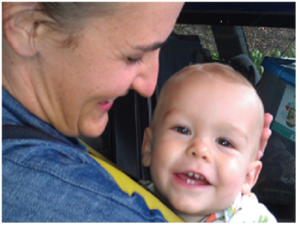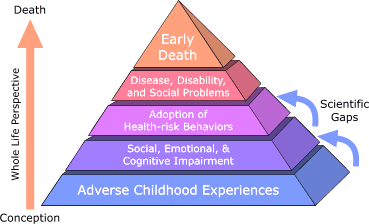#4 in my ongoing book series; original post August 9, 2013
 If there’s been an Adult Attachment Interview (AAI) since 1996 which can diagnose the 50% of Americans with attachment disorder, why doesn’t our medical system use it? [FN12a]
If there’s been an Adult Attachment Interview (AAI) since 1996 which can diagnose the 50% of Americans with attachment disorder, why doesn’t our medical system use it? [FN12a]
Why aren’t family doctors asking why a patient “just feels lousy” for years, to send us at least for one AAI check by a therapist? Why haven’t more than a small minority of therapists even heard of the AAI? Using it would’ve saved me three years in failed treatment hell.
Instead it’s been left to activists like comedienne Goldie Hawn, alarmed by the jump in stress and violence among children, to put attachment specialists like UCLA’s Dr. Dan Siegel, MD on TV with plastic models of the brain, to wake us all up. Check out the priceless video above. “You sent us a brain in the mail !” Anderson Cooper exclaims. [FN12b]
Models of the brain and brain science show a lot: where Attachment Disorder gets created, why we don’t even know that it’s there, and how to heal it.
Most of what occurred with family or caregivers in the almost 4 years from conception to 36 months, which makes us securely or in-securely attached, happened ‘way before we had much of a thinking brain – and before we had any conscious memory banks. So we still fly blind about it today.
Our brain parts which allow us to calm ourselves, feel good alone, or even make sense of sights, sounds, touch, and other sensory data pouring in from outside, weren’t working at the time attachment misfired. Babies can’t self-calm or feel good alone. The “thinking brain” hippocampus which makes sense of that barrage of incoming data, doesn’t even work until 24 to 36 months. That’s why we can’t remember much before age 3.
But the problem is down there, in the pre-thinking, un-conscious parts of the brain which were online, and down in our body with a vengeance. We can have cancer for a long time and be unaware of it until late in the game. Attachment Disorder too is usually an 800lb gorilla which is utterly outside of consciousness. Yet wounded un-conscious parts of our brain have been in a state of panic since attachment misfired before age 3.
Hole in My Heart
 “There’s a hole in my heart,” or “a hole under my feet,” people report. We’re anxious, panicky, depressed about being dropped off at school, or to do work, marriage, child rearing. We feel unequipped to do Life.
“There’s a hole in my heart,” or “a hole under my feet,” people report. We’re anxious, panicky, depressed about being dropped off at school, or to do work, marriage, child rearing. We feel unequipped to do Life.
I’d felt emotional pain as a “hole in my heart” ever since I could remember; I alternated between denial and praying my parents wouldn’t notice my fear. My first memory of TV was a documentary about an early open-heart surgery on a “blue baby” born with cardiac perforation.
As the camera showed a scalpel probing a gap in bloody tissue, the announcer intoned, “Here is the hole in Julie’s heart.” I couldn’t forget the sight and my terror at the announcer’s voice for years. Fairy tales with witches, children’s stories like Peter and the Wolf, TV and movies were as likely to terrify me as a kid as to entertain. “Normal?” Anything resonate?
One day in 2010, I went to my local library on a job request for a sale coaching book, a branch so small that self-help and psychology were shelved together. I stumbled on books of case studies of people whose parents died early, like “The Loss That Is Forever: The Lifelong Impact of the Early Death of a Mother or Father,” by Dr. Maxine Harris. [FN13a] “Irrelevant, my parents died in 2008,” I said, but tossed the book in my car trunk with the rest. There it sat for six weeks until the night before due date.
I opened it and was blown away. The case studies report exactly the disoriented feelings I’d had all my life. A week later my branch closed for two years renovation; what an accident.
I wrote this long before I ever saw Cyndi Lauper’s video “Hole in My Heart,” but it’s a shock how empty she feels inside. [FN13b] “I’ve got a hole in my heart that goes all the way to China!” she wails, “You gotta fill it up with love before I fall inside… You can’t see the bottom, you can’t see the bottom, but believe me – it’s a long way down…”
Poor Cyndi, she thinks the hunky guys who bail her out at the end are gonna solve her problem. She doesn’t know her pain is from her childhood emotions about parents. Those hunks are just gonna hurt her again.
OK, so that’s Psychiatry 101: “80% of the pain in adult romantic relationships is projecting the pain we received in childhood.” [FN14] Trouble is, 99% of Americans are unaware of that fact, and we 50% with Attachment Disorder fight it tooth and nail. We want someone to hold us so bad we could die – someone, anyone, who cares! So don’t confuse us with the facts. But it never works, ‘cos it’s a flight from reality.
Emotional Object Constancy
There’s a way out, recently dubbed neuroplasticity. As the Anderson Live video shows, we can re-train our brains using compassionate therapy, meditation and other “brain gym work” to change the neural structures that hold painful old memories. It was thought that nerve tissue, if damaged, could never heal, but recent science shows the reverse. “We’re hard-wired to heal,” say doctors Henry Cloud and John Townsend. [FN15a]
But to do it, humans require “face time,” face to face work with other “Safe People,” human beings who actually care enough to be present with us. [FN15b] Because it was face time, or lack of it, which damaged our developing brains in the first place.
 Face time is what develops a baby’s brain into an adult brain. An emotionally attuned mother, who feels her baby’s internal states, shows it how to sooth and feel better. She does it wordlessly, with a lot of eye contact (tech term “limbic resonance”). The emotional lobes of the mother’s brain and the baby’s brain actually resonate to each other, as attachment specialist Dr. Allan Schore has shown. [FN16a,16b]
Face time is what develops a baby’s brain into an adult brain. An emotionally attuned mother, who feels her baby’s internal states, shows it how to sooth and feel better. She does it wordlessly, with a lot of eye contact (tech term “limbic resonance”). The emotional lobes of the mother’s brain and the baby’s brain actually resonate to each other, as attachment specialist Dr. Allan Schore has shown. [FN16a,16b]
This is my neighbor and her son, whom she’s carried pretty much constantly for a year in a face-to-face carrier, not because anyone told her to, but because, she says, “it feels natural.” I see them several times a week and I have never seen this baby without a glorious smile.
Like any newborn, he would have cried non-stop at first if she weren’t always there; again, babies don’t have the neural hardware to sooth themselves. But gradually over weeks and months, this baby could be put down for a longer and longer time without getting upset.
“Why should that be?” asks Dr. Henry Cloud. What’s he got now, that he didn’t have before? The mother’s love comes from the outside, then literally goes inside her baby, via limbic resonance. She gives the gift of feeling loved inside to her baby, called “emotional object constancy.”
This is a deep knowing, that we have so warmly attached to mother, the love object, that even when she is absent, we do not feel alone or lonely. We instead feel constancy: we feel that we carry around mom’s love inside us 24×7. This is the source of the strength which allows a healthy child to be dropped off at school and feel so secure inside, that he’s eager to try something new and play with strangers.
The way out of attachment disorder is to create more emotional object constancy, that feeling of deep attachment and safety the baby in the photo has. The reason we feel bad, anxious, depressed or have chronic emotional pain, is usually that this did not develop well when we were kids.
Communicating object constancy to kids is a major reason humans have families. Pre-agricultural man required at least six adults to raise one child safely – four to feed and take care of mom while dad hunted, so mom could safely take care of the child 24 x 7 and get this job done. Who has time for that in this ratty economy? [FN17]
If you have Attachment Disorder, my tale will start to resonate if you let it. If you let yourself feel the hurt with me, you’ll start to unfreeze your frozen bad feelings and if you get the right help, you’ll feel the healing, too.
Secure attachment can be “earned,” as Dr. Mary Main, creator of the AAI, also said. But we need face time with safe people to do it, to widen what Dan Siegel calls our “window of tolerance” to feel frozen feelings.
Days before Christmas 2011 at a local nursery, a friend dared me to sit on Santa’s lap. As I alighted gingerly, he asked, “And what do you want for Christmas, young lady?” Lost and alone for the holidays, I looked the poor guy straight in the eye and blurted without thinking, “Please Sir, I want peace of mind.”
“Don’t we all,” he said, tearing up.
I think I’ll go find the nice man this Christmas 2013 and thank him for making my wish come true.
———————————-
This is from Kathy’s forthcoming book DON’T TRY THIS AT HOME: The Silent Epidemic of Attachment Disorder – How I accidentally regressed myself back to infancy and healed it all. Watch for the continuing series of excerpts from the rest of her book each Friday, as she explores her journey of recovery by learning the hard way about Attachment Disorder in adults, adult Attachment Theory, and the Adult Attachment Interview.
 READ MORE from “DON’T TRY THIS AT HOME: The Silent Epidemic of Attachment Disorder”
READ MORE from “DON’T TRY THIS AT HOME: The Silent Epidemic of Attachment Disorder”
by Kathy Brous
Footnotes
12a. Op Cit blog #3: George, C.; Kaplan, N.; Main, Mary, “An Adult Attachment Interview,” Unpublished MS, University of California at Berkeley, 1994
12b. Siegel, Daniel J.,MD & Hawn, Goldie, TV Special on the Brain, CNN Anderson Live, Sept. 24, 2012. See www.drdansiegel.com/press/ for more; or direct to video at http://cdnapi.kaltura.com/index.php/extwidget/openGraph/wid/0_c40uup5m
13a. Harris, Maxine, PhD, “The Loss That Is Forever: The Lifelong Impact of the Early Death of a Mother or Father,” Penguin Books, New York, 1996
13b. Cyndi Lauper video: www.youtube.com/watch?v=hP9b4zlO2cU
14. Verrier, Nancy, PhD, “Coming Home to Self: The Adopted Child Grows Up,” self-published, Lafayette, CA, 1993
15a. Cloud, Henry, PhD, “Changes that Heal,” Zondervan, Grand Rapids, 1990. See also: “Getting Love on the Inside,” Lecture CD, April 2002, Cloud-TownsendResources.com
15b. Townsend, John, PhD & Cloud, Henry,Phd, “Safe People,” Zondervan Press, Grand Rapids, 1995. Also by both: “Boundaries,” Zondervan Press, Grand Rapids, 2004
16a. Schore, Allan N., PhD, “Affect Regulation and Mind-Brain-Body Healing of Trauma,” National Institute for the Clinical Application of Behavioral Medicine (NICABM), June 15, 2011, www.nicabm.com See also his book “Affect Regulation and the Origin of the Self”, Norton textbook May 2003; first edition 1994.
16b. Op Cit blog #2: Lewis, Thomas MD, Amini, Fari MD, Lannon, Richard MD; “A General Theory of Love”,Random House, 2000. Great link: www.paulagordon.com/shows/lannon/
17. Perry, Bruce, MD, PhD, “Born for Love: The Effects of Empathy on the Developing Brain,” speech at conference “ How People Change: Relationship & Neuroplasticity in Psychotherapy,” UCLA Extension, Los Angeles, March 8, 2013. See also his article “Overview of Neuro-sequential Model of Therapeutics (NMT),” www.childtrauma.org, 2010
18,722 total views, 1 views today



Pingback: Separation & Individuation (Pt2) | Heal & Grow for ACoAs